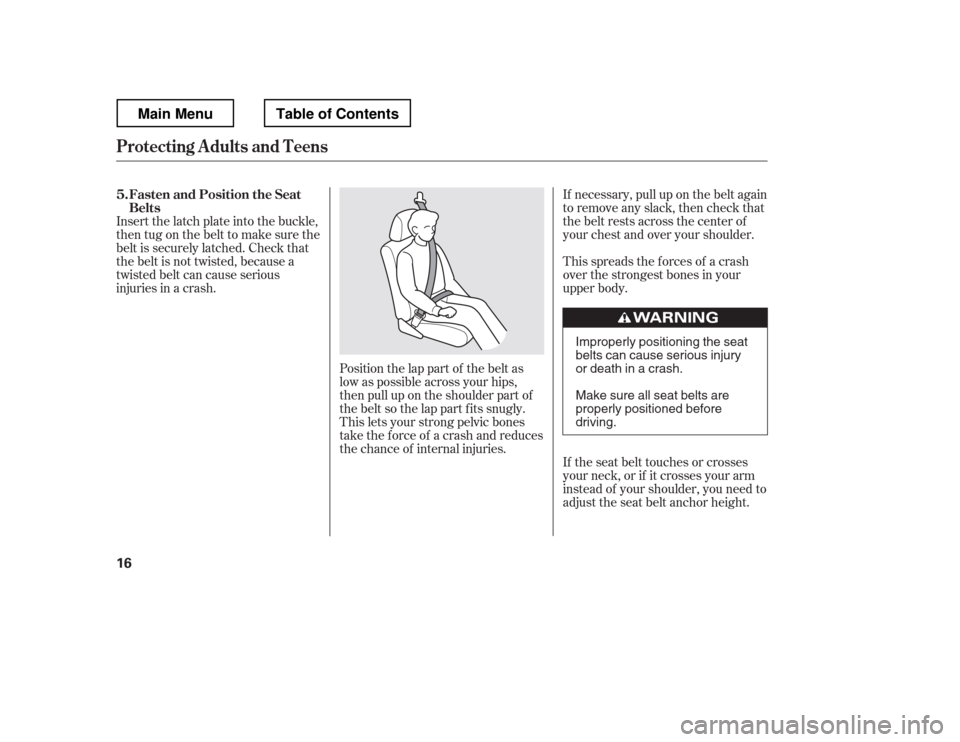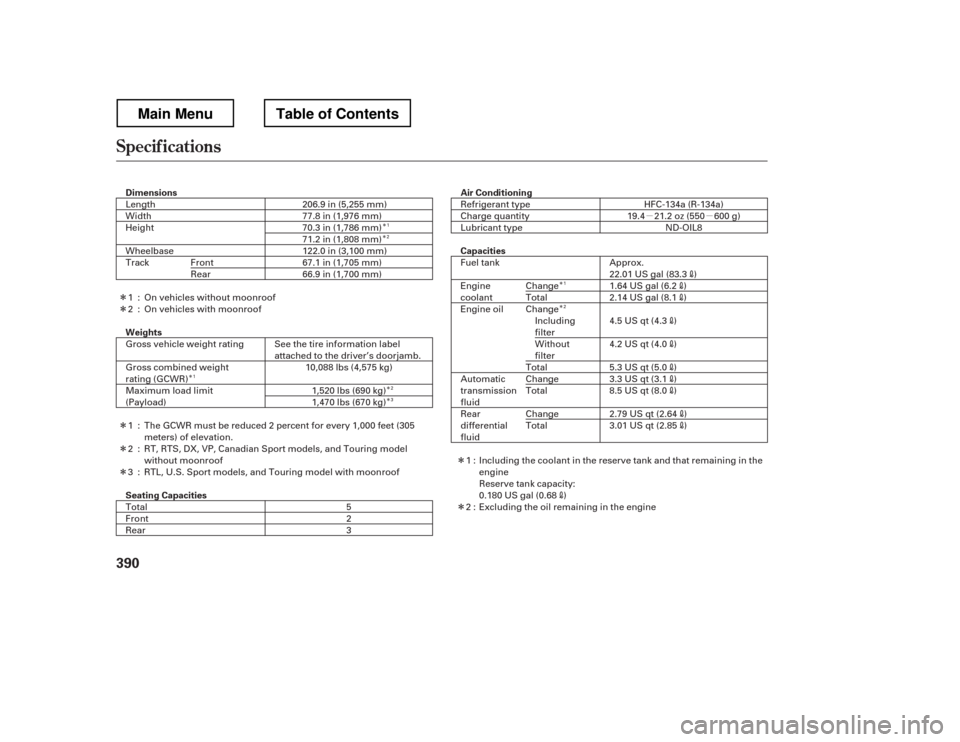Page 23 of 429

Position the lap part of the belt as
low as possible across your hips,
then pull up on the shoulder part of
the belt so the lap part f its snugly.
This lets your strong pelvic bones
take the force of a crash and reduces
the chance of internal injuries.
Insert the latch plate into the buckle,
then tug on the belt to make sure the
belt is securely latched. Check that
the belt is not twisted, because a
twisted belt can cause serious
injuries in a crash.
If necessary, pull up on the belt again
to remove any slack, then check that
the belt rests across the center of
your chest and over your shoulder.
This spreads the f orces of a crash
over the strongest bones in your
upper body.
If the seat belt touches or crosses
your neck, or if it crosses your arm
instead of your shoulder, you need to
adjust the seat belt anchor height.
Fasten and Position the Seat
Belts
5.
Protecting A dults and Teens
16 Improperly positioning the seat
belts can cause serious injury
or death in a crash.
Make sure all seat belts are
properly positioned beforedriving.
Table of ContentsMain Menu
Page 24 of 429

CONT INUED
This could cause
very serious injuries in a crash.
See page f or additional
inf ormation about your seat belts
and how to take care of them.
The front seats have adjustable seat
belt anchors. To adjust the height of
an anchor, squeeze the two release
buttons, and slide the anchor up or
down as needed (it has f our
positions). After all occupants have adjusted
their seats and head restraints, and
put on their seat belts, it is very
important that they continue to sit
upright, well back in their seats, with
their feet on the floor, until the
vehicle is safely parked and the
engine is of f .
Using a seat
belt that is not working properly can
result in serious injury or death.
Have your dealer check the belt as
soon as possible. Sitting improperly can increase the
chance of injury during a crash. For
example, if an occupant slouches,
lies down, turns sideways, sits
forward, leans forward or sideways,
or puts one or both f eet up, the
chance of injury during a crash is
greatly increased.
If a seat belt does not seem to work
properly, it may not protect the
occupant in a crash.
20
Protecting A dults and Teens
Never place t he shoulder port ion of alap/shoulder belt under your arm or behind your back.
No one should sit in a seat with aninoperat ive seat belt .Maintain a Proper Sitting
Position
6.
Driver and Passenger Saf ety
17
RELEASE
BUTTONS
Table of ContentsMain Menu
Page 127 of 429
Make sure to pull the lever upward
or downward to its f ull range.
Make all seat adjustments bef ore
you start driving.
To change the seat-back angle of the
f ront seat, pull up the lever on the
outside of the seat bottom.
Once a seat is adjusted correctly,
rock it back and f orth to make sure it
is locked in position. The height of your driver
Page 312 of 429
The added weight, length, and
height of a trailer will af f ect your
vehicle
Page 397 of 429

�µ�µ
�Î �Î
�Î �Î �Î
�Î
�Î
�Î �Î �Î�Î �Î
�Î
�Î
Specif ications
390 Air Conditioning
Dimensions
Capacities
Weights
Seating Capacities 206.9 in (5,255 mm)
77.8 in (1,976 mm)
70.3 in (1,786 mm)
Refrigerant type
Charge quantity
Lubricant type HFC-134a (R-134a)
19.4 21.2 oz (550 600 g) ND-OIL8
1,470 lbs (670 kg)
1,520 lbs (690 kg)
10,088 lbs (4,575 kg)
Length
Width
Height
Wheelbase
Track
66.9 in (1,700 mm)
67.1 in (1,705 mm)
122.0 in (3,100 mm)
The GCWR must be reduced 2 percent for every 1,000 feet (305
meters) of elevation. Fuel tank
Engine
coolant
Engine oil Automatic
transmission
fluidRear
differential
fluid
22.01 US gal (83.3
)
1.64 US gal (6.2)
2.14 US gal (8.1)
4.2 US qt (4.0
)
4.5 US qt (4.3
)
5.3 US qt (5.0
)
3.3 US qt (3.1)
8.5 US qt (8.0)
2.79 US qt (2.64
)
3.01 US qt (2.85)
Including the coolant in the reserve tank and that remaining in the
engine
Reserve tank capacity:
0.180 US gal (0.68
)
Excluding the oil remaining in the engine
71.2 in (1,808 mm)
Gross vehicle weight rating
Gross combined weight
rating (GCWR)
Maximum load limit
(Payload) See the tire information label
attached to the driver’s doorjamb.
3
2
5
Total
FrontRear Approx.
FrontRear
1: 2:
1: 2: 3:
Change Total
Change
Including
filter
Without
filter
Total
ChangeTotal
Change Total
1:
2:
On vehicles without moonroof
On vehicles with moonroof
RT, RTS, DX, VP, Canadian Sport models, and Touring model
without moonroof
RTL, U.S. Sport models, and Touring model with moonroof 1
231 2
1
2
Main MenuTable of Contents